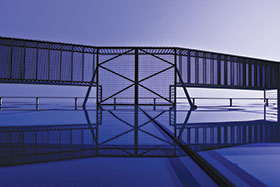

Given the fact that physical barriers such as fences are hard to maintain and that some topographies do not lend themselves to installations, what tools exist to protect South Africa’s borders?
Some of the issues that require more stringent control of the passage of people in and out of South Africa include car theft, human trafficking, cash-in-transit (CIT) heists, arms and drugs smuggling. While it is important to provide a visible as well as a covert patrolling presence on our borders with other countries as well as points of entry from other countries, this needs to be supplemented with technology.
On the perimeter

Kelly McLintock of Blacklight Consulting says we should consider other international border security success stories when protecting and monitoring our border boundaries. He cites the US-Mexico border as being too vast to completely cover with manpower. “The US government therefore uses X band or S band radar for situational awareness of these areas. They also use drones on a scheduled basis, together with thermal cameras or LIDAR (Light Detection and Ranging). Ground-based radar has also evolved to a point where strategic location response teams can be used instead of broad-ranging patrols. In addition, there is increasing use of K9 units for tracking potential threats along borders.”
He points out that there are natural borders such as rivers and mountains, but these are no longer necessarily a deterrent to those wishing to enter or leave the country illegally. In Africa specifically, it is important to take a layered approach to border security. This starts with mechanical measures such as electric fences, with large-area surveillance added on through the use of radar or drones to ensure maximised visibility of both the ‘hot spot’ areas or on a global overview basis.
With the advent of ground awareness based radar technology, governments have been able to monitor large areas with little manpower and then use small, skilled teams to cover events identified by the radar.

Philip Smerkovitz of TeleEye says that it is common knowledge that there is a large amount of work to be done to secure South Africa’s physical borders in terms of fixing, maintaining and replacing fencing.
“This will consume huge amounts of capital and affects a number of government departments that include the South African National Defence Force (SANDF) who are responsible for patrolling borders and responding to threats; the Department of Home Affairs (DoHA) who are under immense pressure from the multitude of illegal immigrants entering the country and placing strain on the economy; the Department of Health (DoH) who deal with a number of pregnant alien immigrants entering South Africa to have their babies and thereby claiming citizenship for them; and the South African Police Services (SAPS) who deal with, for instance, Mozambican syndicates who are involved with stealing cars and CIT heists,” says Smerkovitz.

Paul Jeremias of IDEMIA concurs and adds that the legacy that we have had over the years with limited coordination between stakeholder agencies is the main reason why there is so much interest in the proposed Border Management Agency that will improve the management and coordination of the country’s borders.
Smerkovitz says that it is possible to have a fence-less border by using long-range buried fibre technology which comprises a control box placed at 50 km intervals to detect movement in that area. These are complemented by high towers fitted with surveillance cameras that can cover an area of 15 km. “When the fibre controller detects movement, the camera will zoom into that location and send a verification which will in turn activate the deployment of response teams. Be aware though that one cannot point a camera into another country and therefore all cameras need to be masked.”
Little brother
Drones are the perfect tools for covering longer distances, but McLintock cautions that this is a highly regulated industry. A suitable military-spec drone can be used for surveillance, visual verification and tracking the identified threat.
Military clearance allows these drones to fly higher than commercial drones and they can remain airborne for many hours. Border patrol drone pilots are regulated by both the Civil Aviation Authority and the South African Air Force. Like other cameras on borders, privacy is a prerequisite when filming and only footage of one’s own country or the no-man’s land between countries is permitted. This factor therefore limits drone usage.
McLintock says that because of their higher flying elevation, it is highly unlikely that these moving targets would be vulnerable to the criminal element. Likewise, anti-drone technology is not readily available in South Africa.
Please enter
Smerkovitz says that while the entire border perimeter may be difficult to monitor and control, the exit and entry points are much more manageable. For example, one can deploy conventional CCTV technology with analytics to conduct queue management of people and vehicles. In addition, vehicle counting can be programmed into analytics, together with licence plate recognition.

Walter Rautenbach of neaMetrics, distributor of Suprema in Africa, says that border security definitely ventures beyond physical barriers and security. “Controlling borders is essential, especially in curbing African migration. In a digital society it is so much more convenient to pay someone for falsified travel documents than it is to leopard crawl across weak borders. These falsified documents are also more commonly used by international syndicates involved in terrorism and money laundering, while making it easier to establish residency in a new country with a seemingly legitimate passport.”
It is here where interconnected governments, biometrics and movement control systems need to continuously stay ahead of cyber criminals, he believes. Passports and visas were intended for this purpose, but in the current state it is not close to being the final solution to the problem. The same systems conceptualised and being implemented, to establish a truly unique citizen identity from cradle to grave, needs to be expanded in international terms.
Rautenbach says that strengthening the visa process is a good starting point. Capturing biometric data as part of this process, in your country of residence or at your consulate is definitely a fast-growing tendency and it does allow for positively confirming that you are the citizen you claim to be and then to further positively identifying you to be the same person leaving your residency, crossing foreign borders and then returning home.
The more sophisticated visa systems establish in advance whether a physical interview is required and in some instances one can simply log into a website, add one’s biographic data, then attend the interview where biometric data may be collected and verified. Pre-approval of visa applications allows the country you are visiting to determine if they really want you there so they can avoid the inconvenience of sending you back home once you have already reached the point of entry.
Biometrics at the border
Once one reaches the border post, visa and passport data may be either recorded manually or passports may be scanned for future reference. On a more sophisticated level are biometric-enabled e-passports that are conveniently available for positive identification. However, since not all countries have facilities to produce e-passports, entry cannot be restricted to only holders of the same.
The e-gate systems are also growing in popularity as they make crossing borders much easier. Based on the country’s rules, the system will either just record that one is coming through the border post or it will perform a biometric comparison to ensure that you are actually who you say you are. This effectively alleviates human intervention and greatly improves through-flow of traffic.
Some countries are already moving past pure border entry control by monitoring where you go while visiting, where you are staying, tracking movement by seeing where you swipe your card or where you come in contact with private sector services regulated by government such as mobile SIM registration. This data is extremely useful for future vetting, detecting illicit activities and useful for private sector growth that will generate economic development, such as tourism.
Jeremias says that the DoHA is moving quickly to improve their management of traveller identities and the SAPS can simultaneously play a vital role in identifying people of interest on arrival and departure.
Other components such as body and baggage scanners are available at specific border posts. These elements also have an impact on traveller experiences and the queues they encounter, by speeding up traveller throughput.
Finger, face, iris
Biometrics are becoming increasingly popular as part of border control. With biometrics now being a commodity, it is important to note that all biometrics vendors are not equal. “The value of biometric data is not in capturing and storing the data but in actually using it. This might sound like common sense, but it is definitely not common practice. I have personally come across more than 20 systems, adding up to multi-million biometric identities, captured by governments, government agencies or because of government regulations, where this data to date is not being used at all after capture,” says Rautenbach.
He believes that just checking the boxes by capturing biometrics to comply with government regulations is gross misappropriation of government funds, collected from taxpayers, extracting zero value.
The value lies in using this data for personal authentication such as matching against e-passports, confirming your identity on return visits or when leaving borders, SIM issuance and other regulated private sector services; detecting the same person posing as two different persons and integration with external systems (that is, police, Interpol, civil ID, refugee and deportation databases). “To achieve this, the equipment that you use should comply with international standards, such as regulating quality standards and intersystem operability, it should have a proven international track record and your solution partner must have the experience and skills focused on integration.”
The three most common biometric modalities used at border posts are fingerprint, facial and iris scanning. Fingerprints biometrics is the international standard for criminal systems because this is something you leave at a crime scene. For this reason, this modality remains popular especially when integrating with various systems.
The benefits of facial recognition technology include the fact that it is a contactless modality and can be used for tracking a person from the moment that they enter an airport. Facial recognition technology is non-obtrusive, and if implemented on CCTV infrastructure, provides additional options such as behavioural analytics, useful to proactively detect suspicious behaviour.
Iris technology is growing in popularity, especially in places like the United Arab Emirates, where cultural and religious dress codes prohibit women from displaying any portion of their face, with the exception of their eyes. Again, this is contactless technology, with high levels of accuracy.
Rautenbach also mentions voice recognition technology as a growing modality, not currently widely used in border control or government, but with great potential. Voice was previously tainted by issues of accuracy and potential fraud, now overcome by enhancements of algorithms and techniques that rather analyse voice patterns, allowing authentication and identification which is not ‘phrase’ dependent and which prevents previous fraud that involved covert collection of specific phrases.
This modality opens many new avenues as it can be integrated into call centre infrastructure, web and mobile, without expensive infrastructure. A good example of how this can be used in the visa application is to allow applicants to record their voice on the web when they make their interview booking, confirming the identity with the same during interview, passport collection and border control.
Multi-modal biometrics
“A multi modal approach remains the best option for identification and verification, with authentication improving with each added modality,” he says. Using a multi-modal approach creates higher security, makes the system more difficult to defraud and delivers more identity channels (that is, fingerprints for criminal clearance, voice for call centre, facial for surveillance) making implementation more flexible and assists with a more secure identity profile controlled from start to finish.
Jeremias adds that the idea of incorporating biometrics into the border control process makes sense if you allow people to do it for themselves. “This is the reason that major airports around the world have deployed e-gates for border control or self-service airline facilities (bag drop, check-in, security access, boarding), or public enrolment situations. Consider the solution deployed in late 2017 at Singapore’s award-winning Changi Airport Terminal 4, which enables the passengers to move from the kerbside to the boarding gate within 10 minutes without any compromise in security.”
The passengers at this airport are recognised through facial recognition throughout the journey and guided towards the appropriate security checkpoints.
He cites IDEMIA’s solutions for providing high-speed, high-quality contactless fingerprint scanning using a simple wave of the hand through the reader. It can be used for access control as well as enrolment and authentication at borders. “The great thing about this solution is that it acquires four fingers in less than 1 second and overcomes some of the difficulties experienced with contact prints. The quality of the image is better and it can manage people with poor quality prints and very dry or moist fingers. The image is also larger than a traditional contact print.”
Additionally, IDEMIA has solutions to capture either facial images with liveness detection or iris capture or both at the same time and is a game changer from a biometric perspective. “Imagine capturing two biometrics of a traveller at the same time in less than 1 second and having a confirmation of the traveller’s identity within a maximum of another second after that! From 0.5 to 2 metres high, regardless of ambient lighting conditions.”
Keeping track
Tracking people after they cross into a country may seem to be an impossible task. While a person can to some extent be tracked through the use of additional elements such as mobile SIM card registrations, checking into hotels or spending on a credit card for instance, keeping tabs on them can be very difficult.
Jeremias suggest transferring the biometrics taken at the border to the SAPS in order to include the traveller on watchlists for use at roadblocks. However, the success rate of this is not likely to be notable as the number of people that proceed through a roadblock can be quite limited.
There are definitely challenges in ensuring adequate border security. Firstly, budgets need to be funnelled to the upkeep of mechanical security measures. Secondly, the sheer area to be ‘patrolled’ is vast and cannot be effectively handled with manpower alone. Finally, a very narrow market exists for local integrators, since all technology deployed to ensure coverage of the areas, such as radar and drones, needs to be of a military specification and can only be supplied by government-registered providers.
It is important to understand the threats to the border then consider the deployment of the correct layering for these threats. One also needs to factor in what is happening at any period in time based on socio economic and political issues, such as migrant labour traffic. A solution, together with closing the gaps in the physical border, could be the auto generation of violations in an environment using electronic passport control, thereby controlling illegal travellers within the country.
For more information contact:
• Blacklight Technology Consulting, +27 11 026 7582, [email protected], www.blacklightconsulting.co.za
• IDEMIA, +27 11 286 5800, [email protected], www.idemia.com
• neaMetrics, 0861 632 638, [email protected], www.neametrics.com
• TeleEye (South Africa), +27 11 557 9200, www.TeleEye.com
| Tel: | +27 11 543 5800 |
| Email: | [email protected] |
| www: | www.technews.co.za |
| Articles: | More information and articles about Technews Publishing |

© Technews Publishing (Pty) Ltd. | All Rights Reserved.